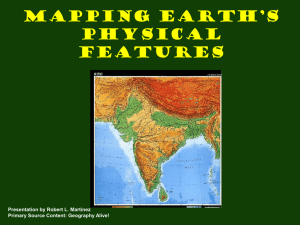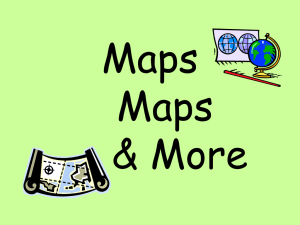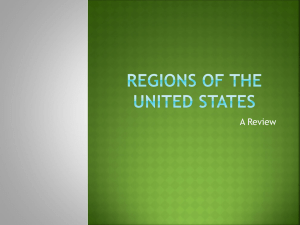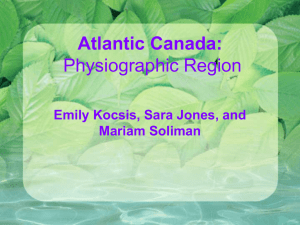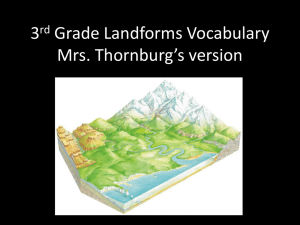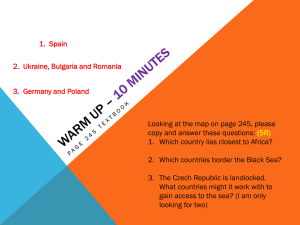10EOWChapter04
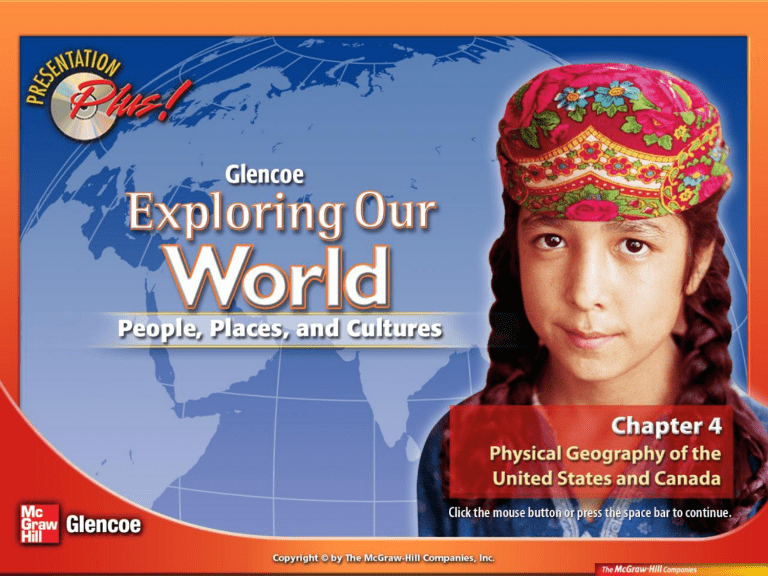
Splash Screen
age fotostock/SuperStock
Physical
Features
Climate Regions
Chapter Menu
Regions The United States and Canada cover most of the land area of North America, stretching from the Pacific
Ocean to the Atlantic Ocean.
These two huge countries share many of the same physical features, resources, and climates.
How do landforms and climate help or hinder transportation in a vast region?
Chapter Intro 1
Section 1:
Physical Features
Geographers organize the
Earth into regions that share common characteristics.
The
United States and Canada share a long border and many landforms. Their economies are closely linked by trade. Their governments have also worked together on major projects that have changed the land and benefited both countries.
Chapter Intro 2
Section 2:
Climate Regions
The physical environment affects how people live.
A diversity of climates in the
United States and Canada leads to different ways of life.
Some parts of this region experience natural hazards that can threaten people’s safety.
Chapter Intro 2
Chapter Intro-End
Geographers organize the Earth into regions that share common characteristics.
Section 1-Main Idea
Content Vocabulary
• contiguous
• megalopolis
• prairie
• cordillera
• canyon
• navigable
• glacier
• divide
Academic Vocabulary
• constrain
• route
Section 1-Key Terms
Have you ever been to Canada?
A.
Yes
B.
No
A
0%
A. A
B. B
0%
B
Section 1-Polling Question
In California’s Redwood National Park, during 2006, naturalists discovered what is now recognized as the world’s tallest tree. Named Hyperion, it is 379.1 feet
(115.5 m) tall —as much as one-and-a-quarter football fields long!
Section 1
Major Landforms
The region rises in elevation from east to west.
Section 1
Major Landforms
(cont.)
• The United States and Canada, covering most of North America, are bordered by the Arctic Ocean in the north, the Atlantic
Ocean to the east, the Gulf of Mexico in the southeast, and the Pacific Ocean in the west.
• Canada occupies most of the northern part of
North America and is the second-largest country in the world after Russia.
• The United States is the third-largest country.
Section 1
Major Landforms
(cont.)
• Most of the United States stretches across the middle part of North America.
• The 48 states in this part of the country are contiguous , or joined together inside a common boundary.
• Alaska lies in the northwestern part of
North America, adjacent to Canada, and
Hawaii is an island group in the Pacific
Ocean.
Section 1
Major Landforms
(cont.)
• A broad lowland runs along the Atlantic and the Gulf of Mexico coasts.
• In northeastern areas, the thin and rocky soil constrains, or limits, farming.
• A fertile, hilly area called the Piedmont stretches inland from the coastal plain.
• Harbors along the Atlantic coast have led to the growth of shipping ports.
Section 1
Major Landforms
(cont.)
• The cities of Halifax, Boston, New York
City, Philadelphia, and Washington, D.C., all lie along or near the Atlantic coast, forming a connected area of urban communities called a megalopolis .
• The coastal plain along the Gulf of Mexico is wider than the Atlantic plain, and soils in this region are better than those along the
Atlantic coast.
Section 1
Major Landforms
(cont.)
• Large cities here include Houston and
New Orleans. West and north of the eastern coastal plain are highland areas that include the Appalachian Mountains.
• West of the eastern highlands are vast interior lowlands.
• In the north lies the Canadian Shield, a horseshoe-shaped area of rocky hills, lakes, and evergreen forests that wraps around the Hudson Bay.
Section 1
Major Landforms
(cont.)
• With poor soil and a cold climate, the
Canadian Shield is not farmable, but it does contain many mineral deposits such as iron ore, copper, and nickel.
• South of the Canadian Shield and west of the Appalachians lie the Central Lowlands with grassy hills, rolling flatlands, thick forests, and fertile farmland.
Section 1
Major Landforms
(cont.)
• Important waterways are the Great Lakes and the Mississippi River.
– Chicago, Detroit, and Toronto are located here.
Section 1
Major Landforms
(cont.)
• The Great Plains stretch west of the
Mississippi River, gradually rising in elevation from east to west.
• Much of this region is a prairie , or rolling inland grassland with fertile soil.
• Grains, cattle, and reserves of coal, oil, and natural gas are important products here.
Section 1
Major Landforms
(cont.)
• West of the Great Plains is a cordillera , or a group of mountain ranges that run side by side.
• At the eastern edge of the cordillera, the
Rocky Mountains begin in Alaska and run south to New Mexico.
• Near the Pacific coast, the Sierra Nevada, the Cascade Range, the Coast Range, and the Alaska Range mountain chains make up the western part of the cordillera.
Section 1
Major Landforms
(cont.)
• Mount McKinley in the Alaska Range rises to 20,320 feet (6,194 m), the highest point in North America.
• Between the Pacific ranges and the Rocky
Mountains is a stretch of dry basins and high plateaus.
• In the southern part of this area, rivers have worn through rock to create canyons , or deep valleys with steep sides, including the Grand Canyon of the
Colorado River.
Section 1
Which statement is true about the
Appalachian Mountains?
A.
Contains tallest U.S. mountain
B.
Oldest mountain range in U.S.
C.
Rich in gold deposits
D.
Both A and C
A
0%
A. A
B. B
C. C
0%
D. D
C
0%
D
Section 1
Bodies of Water
The region’s waterways provide transportation and electric power.
Section 1
Bodies of Water
(cont.)
• The United States and Canada have numerous freshwater lakes and rivers.
• Many of the region’s rivers are navigable , or wide and deep enough to allow the passage of ships.
• The Great Lakes—the world’s largest group of freshwater lakes —lie in the central part of the region.
Section 1
Bodies of Water
(cont.)
• Thousands of years ago, glaciers formed
Lake Superior, Lake Michigan, Lake
Huron, Lake Erie, and Lake Ontario.
• The waters of these connected lakes flow into the St. Lawrence River, which empties into the Atlantic Ocean.
St. Lawrence Seaway and Locks
Section 1
Bodies of Water
(cont.)
• The St. Lawrence River, one of Canada’s most important rivers, flows for 750 miles
(1,207 km) from Lake Ontario to the Gulf of St. Lawrence in the Atlantic Ocean.
– Quebec, Montreal, and Ottawa developed in this area.
St. Lawrence Seaway and Locks
Section 1
Bodies of Water
(cont.)
• For many years, various obstructions kept ships from navigating the entire route, or journey, from the Great Lakes to the
Atlantic Ocean.
• Then, in the mid-1900s, the United States and Canada built the St. Lawrence Seaway, which links these bodies of water.
St. Lawrence Seaway and Locks
Section 1
Bodies of Water
(cont.)
• The Mississippi river is North America’s longest river. It flows 2,350 miles (3,782 km), beginning as a stream in Minnesota and enlarging to a width of 1.5 miles (2.4 km) before emptying into the Gulf of Mexico.
• The Mississippi River system is the major waterway for the central region.
• It drains about 1.2 million square miles (3.1 million sq. km) of land, including all or part of
31 American states and much of central
Canada.
Section 1
Bodies of Water
(cont.)
• The high ridge of the Rocky Mountains is called the Continental Divide. A divide is a high point that determines the direction that rivers flow.
• Northeast of the Rockies, the Mackenzie
River flows from the Great Slave Lake to the
Arctic Ocean, draining much of northern
Canada’s interior.
Section 1
Which of the following is NOT a
“Great Lake”?
A.
Lake Ontario
B.
Lake Champlain
C.
Lake Michigan
D.
Lake Huron
A. A
B. B
0%
A B
D. D
0%
D
Section 1
Natural Resources
The region has many energy, mineral, and other natural resources.
Section 1
Natural Resources
(cont.)
• Although the United States has oil and natural gas reserves, the country uses nearly three times the amount of oil that it produces and must import more in order to meet the nation’s needs.
• Canada exports both oil and natural gas, much of it to the United States.
• Canada’s area in or near the province of
Alberta has the world’s largest reserves of oil in the form of oil mixed with sand.
Section 1
Natural Resources
(cont.)
• The United States and Canada also have significant amounts of coal.
– Coal is mined in the Appalachian
Mountains, Wyoming, and British
Columbia.
Section 1
Natural Resources
(cont.)
• The rivers and lakes in some areas of the
United States and Canada provide hydroelectric energy.
– Niagara Falls is a major source of hydroelectric power for both countries.
Section 1
Natural Resources
(cont.)
• Farmers grow corn in the Central
Lowlands, which receive plentiful rainfall, and wheat on the drier Great Plains.
• The wet, mild climate of western
Washington and Oregon supports dairy farming and the growing of fruits and vegetables.
• Irrigation is used in the drier eastern areas of these two states to grow grain.
Section 1
Natural Resources
(cont.)
• The warm, wet valleys of central California yield more than 200 different crops.
• In the south central part of British
Columbia, fruits and vegetables are grown on irrigated land.
Section 1
Natural Resources
(cont.)
• Today, forests cover less than 50 percent of Canada and about one-third of the
United States.
– Still, lumber and wood products, such as paper, are major Canadian exports.
Section 1
Natural Resources
(cont.)
• The timber industry is also strong in the states of Oregon and Washington.
• Coastal waters are important to the region’s economy and support large fishing industries.
• In recent years, however, the region’s
Atlantic fishing grounds have suffered from overfishing.
Section 1
Which of the following is a major export of Canada?
A.
Natural gas
B.
Lumber
C.
Coal
D.
All of the above
A. A
B. B
0%
A B
D. D
0%
D
Section 1
Section 1-End
The physical environment affects how people live.
Section 2-Main Idea
Content Vocabulary
• drought
• tornado
• hurricane
• blizzard
Academic Vocabulary
• diverse
• adapt
• restore
Section 2-Key Terms
Does the area you live in experience tornadoes?
A.
Yes
B.
No
A
0%
A. A
B. B
0%
B
Section 2-Polling Question
The Great New England Hurricane of 1938 tore through
Rhode Island, Connecticut, and Massachusetts, killing nearly 600 people and injuring three times that many.
The destruction of homes, other structures, boats, and the fishing industry was almost immeasurable. Unlike today, the storm was hardly reported by national newspapers and radio stations.
Section 2
A Varied Region
Most people in the United
States and Canada live in temperate climate regions.
Section 2
A Varied Region
(cont.)
• The vast territory of the United States and
Canada is diverse in both climates and vegetation.
• Most people live in the middle latitudes where climates are more moderate.
• The extremely cold tundra climate along the Arctic Ocean’s coastline prevents the growth of trees and most plants.
United States and Canada: Climate Zones
Section 2
A Varied Region
(cont.)
• In the subarctic region farther south, forests of evergreens are specially adapted to the climate.
• The area from southern Alaska to northern
California has a marine west coast climate of year-round mild temperatures and abundant rainfall.
United States and Canada: Climate Zones
Section 2
A Varied Region
(cont.)
• Southern California has a Mediterranean climate of warm, dry summers and mild, wet winters with much less rainfall than in northern areas.
United States and Canada: Climate Zones
Section 2
A Varied Region
(cont.)
• The inland West has a desert climate of hot summers and mild winters. Here, Pacific coastal mountains block humid ocean winds.
• Hot, dry air gets trapped between the
Pacific ranges and the Rockies, resulting in little rainfall in the inland West.
• Areas on the eastern side of the Rockies have a partly dry steppe climate.
United States and Canada: Climate Zones
Section 2
A Varied Region
(cont.)
• Droughts , or long periods without rainfall, are a serious challenge to farmers and ranchers who can lose crops and animals.
• The Great Plains have a humid continental climate with cold, snowy winters and hot, humid summers.
United States and Canada: Climate Zones
Section 2
A Varied Region
(cont.)
• Enough precipitation falls to support prairie grasses and grains, although dry weather sometimes affects the area.
• In the 1930s, winds eroded loose topsoil and turned the area into a wasteland called the
Dust Bowl, but today’s better farming methods have restored this area’s soil.
United States and Canada: Climate Zones
Section 2
A Varied Region
(cont.)
• The eastern United States and Canada have humid climate regions with plenty of yearround precipitation.
• The northeastern United States and some areas of eastern Canada have a humid continental climate.
United States and Canada: Climate Zones
Section 2
A Varied Region
(cont.)
• The southeastern United States has a humid subtropical climate.
• In summer, warm air from the south blocks cold Arctic air from reaching the eastern areas.
United States and Canada: Climate Zones
Section 2
A Varied Region
(cont.)
• In winter, however, the northeast receives strong blasts of icy Arctic air.
– For example, in Boston, Massachusetts,
January temperatures can drop to an average low of 22ºF (–6ºC).
United States and Canada: Climate Zones
Section 2
A Varied Region
(cont.)
• Areas in the southeast still receive some warmth from the south, resulting in an average January temperature in Atlanta,
Georgia, of 41ºF (5ºC).
• Southern Florida has a tropical dry climate, with hot temperatures in summer and warm winters.
• Rainfall occurs mainly during the summer.
United States and Canada: Climate Zones
Section 2
A Varied Region
(cont.)
• Hawaii, the other tropical area, has yearround temperatures that average above
70ºF (21ºC).
• Rainfall, which varies throughout the state, supports tropical rain forests.
United States and Canada: Climate Zones
Section 2
Which state has a tropical climate?
A.
Texas
B.
Hawaii
C.
Florida
D.
Both B and C
A. A
B. B
A
0%
B
D. D
0%
D
Section 2
Natural Hazards
Hurricanes, tornadoes, and earthquakes can threaten parts of the region.
Section 2
Natural Hazards
(cont.)
• A tornado is a windstorm in the form of a funnel-shaped cloud that often touches the ground.
• Tornadoes are often associated with strong lines of thunderstorms and may have winds of more than 300 mph (482 km per hour).
• The central United States, called “Tornado
Alley,” sees more tornadoes each year than any other place in the world.
Section 2
Natural Hazards
(cont.)
• Hurricanes are wind systems that form over the ocean in tropical areas and bring violent storms with heavy rains.
• They also can create a storm surge, or high levels of seawater that flood low-lying coastal areas.
• Hurricanes most often strike along the southeastern Atlantic coast and the Gulf of
Mexico, but they can also hit northeastern states.
Section 2
Natural Hazards
(cont.)
• One of the most damaging hurricanes in history, Hurricane Katrina, struck the coast of the Gulf of Mexico in August of 2005, damaging a wide area from Mobile,
Alabama, to New Orleans, Louisiana.
• More than 1,800 people died, and hundreds of thousands lost their homes.
Section 2
Natural Hazards
(cont.)
• Blizzards are severe winter storms that last several hours and combine high winds with heavy snow, sometimes causing
“white-out” conditions that limit how far people can see.
Section 2
Natural Hazards
(cont.)
• While earthquakes can occur anywhere in the region, most take place along the
Pacific coast.
• This area lies along various fault lines, or areas of weakness in the Earth where two tectonic plates meet.
Section 2
Natural Hazards
(cont.)
• The area where tectonic plates meet can also be the site of volcanoes.
– Volcanoes are found in the Pacific coast mountains, southern Alaska, and Hawaii.
– Most are now dormant, or unlikely to erupt soon.
– Several of Hawaii’s volcanoes are still active.
Section 2
In North America, where are volcanoes found?
A.
South west
B.
Northern Alaska
C.
Hawaii
D.
All of the above
0%
A
A. A
B. B
B
D. D
0%
D
Section 2
Section 2-End
Major Landforms
• The East has low coastal plains and heavily eroded highlands.
• Lowland areas with minerals and rich soil make up the region’s interior.
• The West has several parallel mountain ranges. Plateaus, basins, and valleys lie between the mountains.
VS 1
Major Bodies of Water
• The Great Lakes and the St. Lawrence
Seaway support trade between the region’s interior areas and other parts of the world.
• The Mississippi River is the most important waterway in the central part of the United
States.
VS 2
Natural Resources
• The region’s energy resources include oil, natural gas, and coal.
• Abundant mineral resources are found in the eastern highlands, the Canadian Shield, and the western mountains.
• Rich soils support farming in the Central
Lowlands, the Great Plains, and western valleys.
VS 3
Climate Regions
• Most Americans and Canadians live in moderate, middle-latitude climate areas.
• The inland West has dry and semidry climates because mountains block moist air.
• Pacific coastal areas generally have mild, wet climates.
VS 4
Natural Hazards
• Tornadoes occur primarily in the central area of the region.
• Hurricanes can bring heavy winds and rain to the Atlantic and Gulf coasts.
• Earthquakes are a destructive threat along coastal fault lines in the West.
• Volcanoes are found in western coastal areas, Alaska, and Hawaii. Most are dormant.
VS 5
VS-End
Figure 1
Figure 2
PP Trans
DFS Trans 1
DFS Trans 2
contiguous
joined together inside a common boundary
Vocab1
megalopolis
huge urban area made up of several large cities and nearby communities
Vocab2
prairie
rolling inland grassland region with fertile soil
Vocab3
cordillera
region of parallel mountain chains
Vocab4
canyon
deep valleys with steep sides
Vocab5
navigable
referring to a body of water wide and deep enough for ships to use
Vocab6
glacier
giant sheets of ice
Vocab7
divide
the high point in a landmass that determines the direction rivers flow
Vocab8
constrain
limit
Vocab9
route
journey
Vocab10
drought
long period of time without rainfall
Vocab11
tornado
severe windstorm that takes the form of a funnel-shaped cloud and often touches the ground
Vocab12
hurricane
wind system that forms over the ocean in tropical areas and brings violent storms with heavy rains
Vocab13
blizzard
severe winter storm that lasts several hours and combines high winds with heavy snow
Vocab14
diverse
varied
Vocab15
adapt
change
Vocab16
restore
return; to put or bring back into existence or use
Vocab17
To use this Presentation Plus! product:
Click the Forward button to go to the next slide.
Click the Previous button to return to the previous slide.
Click the Home button to return to the Chapter Menu.
Click the Transparency button from the Chapter Menu, Chapter Introduction, or
Visual Summary slides to access the transparencies that are relevant to this chapter. From within a section, click on this button to access the relevant Daily
Focus Skills Transparency.
Click the Return button in a feature to return to the main presentation.
Click the Geography Online button to access online textbook features.
Click the Reference Atlas button to access the Interactive Reference Atlas.
Click the Exit button or press the Escape key [Esc] to end the chapter slide show.
Click the Help button to access this screen.
Links to Presentation Plus! features such as Graphs in Motion, Charts in Motion, and figures from your textbook are located at the bottom of relevant screens.
Help
This slide is intentionally blank.
End of Custom Shows
